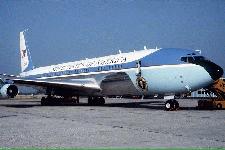
The VC-137 provides transportation for the vice president, cabinet and congressional members, and other high-ranking U.S. and foreign officials. It also serves as a backup for Air Force One, the presidential aircraft.
The VC-137B/C Stratoliner is a modified version of the Boeing 707 commercial intercontinental airliner that, for many years, was the presidential aircraft. Today, the president's aircraft, is the VC-25A. The VC-137B/C body is identical to that of the Boeing 707, but has different interior furnishings and electronic equipment. The passenger cabin is divided into three sections:
- The forward area has a communications center, galley, lavatory and an eight-seat compartment.
- The center section is designed as an airborne headquarters with conference tables, swivel chairs, projection screen for films and two convertible sofa-bunks.
- The rear section of the cabin contains double reclining passenger seats, tables, galley, two lavatories and closets. Partitions may be placed throughout the cabin for added privacy.
Background
In 1962, the first jet aircraft to be specifically purchased for use as "Air Force One," a VC-137B, entered service with the tail number 26000. It is perhaps the most widely known and has the most historical significance of the presidential aircraft. Tail number 26000 is the aircraft that carried President John F. Kennedy to Dallas, Nov. 22, 1963, and in which his body was returned to Washington, D.C., following his assassination. Lyndon B. Johnson was sworn into office as the 36th president of the United States on board 26000 at Love Field in Dallas. This fateful aircraft also was used to return President Johnson's body to Texas following his state funeral on Jan. 24, 1973. In 1972, President Richard M. Nixon made historic visits aboard 26000 to the People's Republic of China in February and to the Union of Soviet Socialist Republics in May.
Tail number 27000, a G model VC-137, replaced 26000 and carved its place in history when it was used to fly former Presidents Nixon, Ford and Carter to Cairo, Egypt, Oct. 19, 1981, to represent the United States at the funeral of Egyptian President Anwar Sadat.
Specifications | |
| Primary Function | Transport high-priority personnel and backup presidential airlift. |
| Builder | Boeing Company. |
| Power Plant: Four Pratt and Whitney JT3D-3B turbofan engines | |
| Thrust: 18,000 pounds (8,100 kilograms) each engine | |
| Length | VC-137B, 144 feet, 6 inches (48.79 meters); VC-137C, 152 feet, 11 inches (46.33 meters) |
| Height | VC-137B, 41 feet, 4 inches (12.52 meters); VC-137C, 42 feet, 5 inches (12.91 meters) |
| Maximum Takeoff Weight | VC-137B, 258,000 pounds (116,100 kilograms) VC-137C, 322,000 pounds (144,900 kilograms) |
| Wingspan: VC-137B, 130 feet, 10 inches (39.66 meters); VC-137C, 145 feet, 9 inches (44.17 meters) | |
| Range | VC-137B, 5,000 miles (8,000 kilometers); VC-137C, 6,000 miles (9,600 kilometers) |
| Ceiling | 42,000 feet (12,727 meters) |
| Speed | 530 miles per hour (Mach 0.81) |
| Load | VC-137B, 40 passengers; VC-137C, 50 passengers |
| Unit Cost | VC-137B, $36.6 million; VC-137C, $36.2 million |
| Crew | 18 (varies with mission) |
| Date Deployed: | VC-137B, October 1962; VC-137C, August 1972. |
| Inventory | Active force, VC-137B, 3 and VC-137C, 4; ANG: 0; Reserve: 0. |









No comments:
Post a Comment